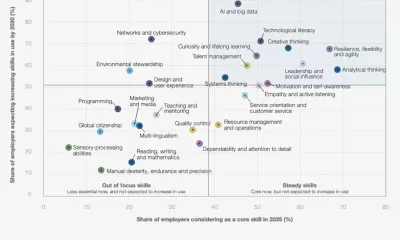Tools
ChatGPT Overtakes Netflix: The Unstoppable Rise of AI and AGI in Asia
As AI reshapes daily life, ChatGPT dominates user engagement and transforming communication, education, and general-purpose tools.
Published
1 year agoon
By
AIinAsia
TL;DR:
- ChatGPT outperforms Netflix in monthly user visits, demonstrating the growing importance of AI tools in daily life.
- AI applications in language enhancement, education, and general-purpose tools are transforming the way we communicate, learn, and interact online.
- Regulatory attention increases as AI’s influence expands, with GPT-based tools dominating the market.
The Unstoppable Rise of AI Tools in Asia: ChatGPT Takes the Lead
Artificial intelligence (AI) and artificial general intelligence (AGI) are revolutionising the digital landscape in Asia, as a recent FlexOS study reveals. AI tools are no longer just popular; they have become indispensable in various aspects of our lives. One standout example is ChatGPT, developed by OpenAI, which has surpassed traditional digital giants like Netflix in monthly user visits.
The Reign of ChatGPT
ChatGPT has captured the attention of users worldwide, boasting an impressive 1.67 billion monthly visits, eclipsing Netflix, Pinterest, and Microsoft. This staggering figure cements its position as a household name, continuing its surge from 2023 and remaining at the pinnacle of AI interaction.

Polishing Language with AI
AI tools are also transforming the way we communicate, with Grammarly AI leading the charge. Serving 30 million users, Grammarly AI enhances communication skills by refining written language. Other top writing aids include SimplifiedAI, ZeroGPT, and Copy.AI, which simplify content creation for millions of users.

Conversing with AI
Character.AI is another platform gaining traction, allowing over 18 million monthly users to engage with AI characters for entertainment and educational purposes. This growing trend demonstrates the increasing comfort of users in interacting with AI for various purposes.

AI’s Role in Education
Education is another sector witnessing significant AI transformation. Brainly, an AI-integrated homework helper, serves as a prime example of AI reshaping educational methodologies. Following Brainly, CourseHero and TurnItIn offer specialised AI-driven learning and integrity tools, further illustrating AI’s impact on education.

General-Purpose AI Tools
ChatGPT’s dominance extends to the general AI market, with a commanding 76% market share. While Bing AI and Bard are contenders, ChatGPT leads the pack. When combined, general-purpose chatbots account for 66% of generative AI tool traffic, showcasing the broad appeal and utility of these AI applications.

The Big Picture
The AI market is segmented, with GPT-based tools dominating, followed by education and writing & editing tools. This diversity in AI applications indicates a wide range of uses and potential for future growth. As AI’s influence expands, it has drawn regulatory attention, with the US Federal Trade Commission (FTC) and the Biden administration taking proactive measures to address potential concerns.

Comment and Share on the Growth of these AI Tools in Asia:
Were you aware of the extent of AI’s influence in Asia? How do you see AI and AGI technologies shaping the future? Share your thoughts in the comments below and don’t forget to subscribe for updates on AI and AGI developments. Together, let’s build a community passionate about embracing the future of technology.
You may also like:
- Top 10 AI Tools That Took Asia by Storm in 2023
- The Rise of AI From Hollywood to Asia
- Mastering ChatGPT in Asia: 7 Simple Steps
- Or try the free version of ChatGPT by tapping here.
Author
Discover more from AIinASIA
Subscribe to get the latest posts sent to your email.
You may like
-


Build Your Own Agentic AI — No Coding Required
-


OpenAI’s New ChatGPT Image Policy: Is AI Moderation Becoming Too Lax?
-


Unearthly Tech? AI’s Bizarre Chip Design Leaves Experts Flummoxed
-


How Did Meta’s AI Achieve 80% Mind-Reading Accuracy?
-


How to Prepare for AI’s Impact on Your Job by 2030
-


We (Sort Of) Missed the Mark with Digital Transformation
Tools
Edit AI Images on the Go with Gemini’s New Update
emini’s latest update brings AI-powered image editing to your fingertips, allowing you to upload and modify images directly in the app. Find out how this new feature is changing the creative game.
Published
5 days agoon
May 10, 2025By
AIinAsia
TL;DR — What You Need to Know:
- Gemini’s new feature allows you to easily upload and modify both AI-generated and personal images, giving users full control over their creative projects.
- You can change backgrounds, replace objects, or add new elements, making the app even more versatile for personal and professional use.
- All images, whether generated or edited, will feature an invisible SynthID watermark, with plans to experiment with visible watermarks for extra security.
Gemini’s New Image Editing Feature: What’s New?
Gemini is stepping up its creative capabilities with a game-changing update that brings AI-powered image editing directly to your fingertips. With this new feature, the Gemini app allows you to upload your own photos and images, then tweak them with ease. Whether you’re experimenting with a new hair colour or replacing an object in your photo, the intuitive editing tools make the process straightforward, even for those with minimal design experience.
Unleash Creativity with AI-Generated Images
But it doesn’t stop at just simple editing. The app also integrates AI generation with images, meaning you can create dynamic, context-driven visuals based on your prompts. Imagine uploading a family photo and having Gemini generate an image of what it would look like with a magical, fantasy backdrop or altered colours. You can even take it a step further by having Gemini create a first draft of a bedtime story about dragons while automatically generating accompanying images to go along with the tale.
Seamless Integration: Image Editing Meets Text Prompts
This level of integration between image creation and text-based prompts unlocks endless creative possibilities, giving you a powerful tool for storytelling, marketing, and digital projects. Plus, it’s all contained within one seamless app, which is a huge bonus for anyone looking to streamline their workflow.
Protecting Your Creative Work with Watermarks
Consistency in image generation is key, and that’s where Gemini’s SynthID watermark comes in. Both generated and edited images now carry an invisible watermark, providing peace of mind for creators who want to retain control over their work. In the coming weeks, Gemini will also begin testing a visible watermark on all images, offering an additional layer of transparency for image attribution and copyright purposes.
Expanding Access to More Creators Worldwide
As Gemini’s native image editing feature rolls out globally, more creators will have access to this highly adaptable tool in over 45 languages, giving rise to a wave of innovative content. With the power to upload, modify, and create from scratch, Gemini is reshaping how we think about digital image manipulation.
Over to YOU!
As AI image editing becomes more accessible, will it blur the lines between authentic creativity and automated content creation?
You may also like:
- Google’s Gemini Chatbot: Faster, Wider, and More Powerful
- The Secret Weapon Against AI Plagiarism: Watermarking
- 7 Effective AI Prompt Strategies to Elevate Your Results Instantly
- Try the new Gemini image editing options by tapping here.
Author
Discover more from AIinASIA
Subscribe to get the latest posts sent to your email.
Marketing
Playbook: How to Use Ideogram.ai (no design skills required!)
Turn text into stunning visuals with Ideogram.ai. This no-jargon guide shows you how to create AI logos, posters, memes, and merch—even as a total beginner.
Published
3 weeks agoon
April 24, 2025By
AIinAsia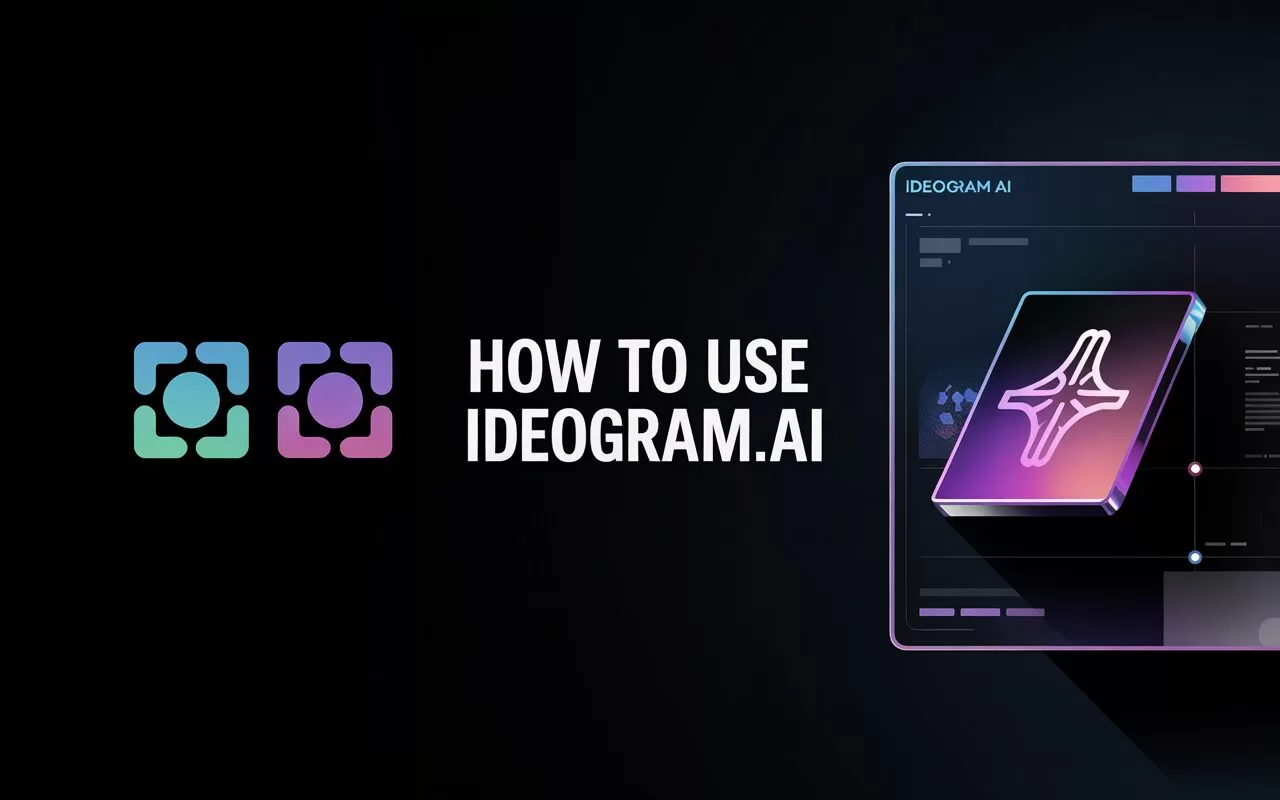
Part of our Prompt and Play series, this article brings AI image magic for anyone who’s ever wished they could turn words into posters, logos, merch, memes—and more.
Whether you’re a total beginner, a brand builder, a creator with too many ideas, or just AI-curious, this guide will help you get the best out of Ideogram.ai—one of the easiest and most fun tools to explore visual creativity through text prompts.
No jargon. No prior experience needed. Just ideas, a keyboard, and a pinch of prompt magic.
1. What is Ideogram.ai – and Why Should You Care?
Ideogram.ai is a free, browser-based tool that turns text prompts into striking images, with one major advantage: it’s actually good at rendering text. That means you can generate logos, signs, posters, and packaging mockups that don’t end up looking like alphabet soup.
You’ve probably seen other AI art tools struggle with spelling—Ideogram has made this its superpower.
What it’s great for:
- Logos and branding mockups
- Posters, merch and marketing visuals
- Social content and memes
- Lettering-based art (neon signs, graffiti, retro fonts, etc.)
The tool’s simple interface, community sharing features, and easy remixing make it one of the most user-friendly creative playgrounds out there—especially if you’re just getting started with AI-generated design.
2. Start Here: Your First 5-Minute Prompt Test Drive
Here’s a super-simple way to get your first result in under 5 minutes:
Try this prompt:
“Logo that says: COFFEE CLUB, in bold black letters, on a white background, minimalist design”
You’ll instantly get 4 images. If you like one, great—download it or remix it. If it’s not quite right, click “Remix” and adjust your words slightly.

Quick win tips:
- Use “that says:” or “with the text:” for best results when adding words.
- Keep your first prompt clear and simple—no need to overcomplicate.
- If you’re not getting readable text, try rephrasing slightly or switching to a simpler style (e.g. “modern logo design” or “minimalist”).
3. Prompt Craft: The Secret Sauce to Better Images
Prompt Formula (use this as your go-to starting point):
[Subject or Object] with [Key Attribute or Message], in [Visual Style or Medium], featuring [Text or Colours], on [Background or Scene].
→ Then adjust based on the output.
Example:
“Festival poster that says: LUNAR VIBES 2025, colourful retro style, glowing neon lights, black background”
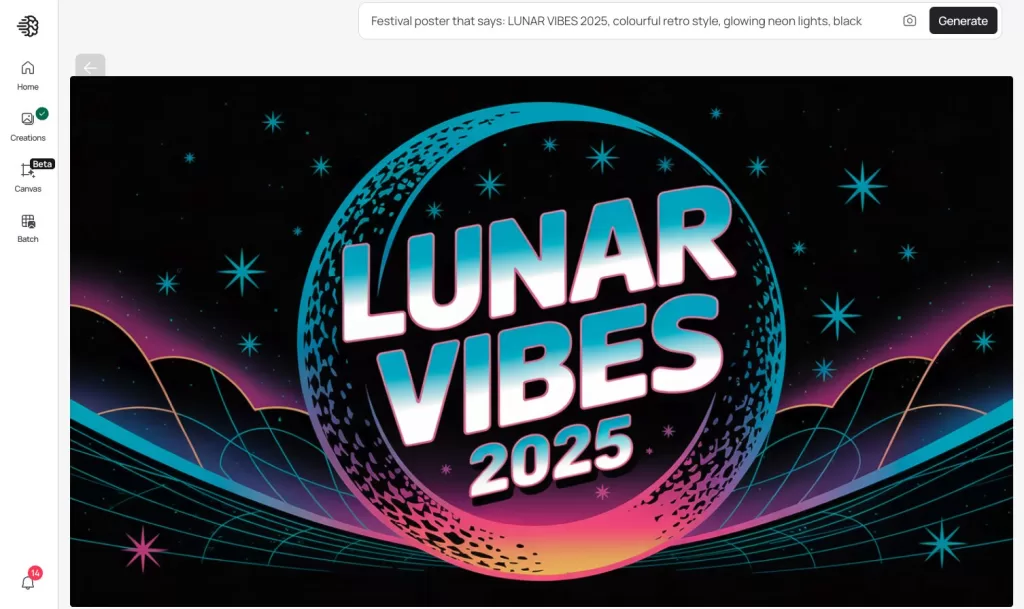
🔍 What to know:
- Text prompting is Ideogram’s strength, so be specific:
“Poster with the text: SALE NOW ON” works better than “Sale poster.” - You can give style guidance like “hand-drawn,” “graffiti,” “pixel art,” or “minimalist.”
- Weights and modifiers like
::are not required—but useful for advanced users.
(e.g. “Cyberpunk city::2, blue tone::1.5, background::0.5”)
❌ Common mistakes:
- Prompting like ChatGPT (“Create a logo for my business…”)—just say what you want!
- Overloading the prompt with too many styles or requests
- Forgetting to use “that says:” when including readable text
4. The Toolbench: Features You Should Actually Use
Let’s break down what matters on-screen:
🎛️ Style Presets
These buttons help nudge your image toward a certain vibe:
- Typography – Great for bold, clean logo text
- Poster Art – Ideal for stylised messaging (events, campaigns, activism)
- 3D Render – Good for packaging mockups
- Illustration / Painting / Pixel Art – Best for storytelling and creative play
🧪 Tip: Style buttons affect how your prompt is interpreted, so try toggling different ones with the same prompt.
🔄 Remix vs Variations
- Remix = Keeps your image but lets you rewrite or tweak the prompt to guide a new version
- Variations = Auto-generates 4 similar images with slight changes (useful if you’re almost there)
✏️ Editing an Existing Creation
Want to change the text, colours, or layout of something you made earlier?
Here’s how to do it:
- Open the image you want to adjust.
- Click “Remix” – this pulls in your original prompt.
- Change only the part you want to improve (e.g. “black background” → “yellow background”; “SALE NOW ON” → “LAST CHANCE!”).
- Click “Generate” to see your updated versions.
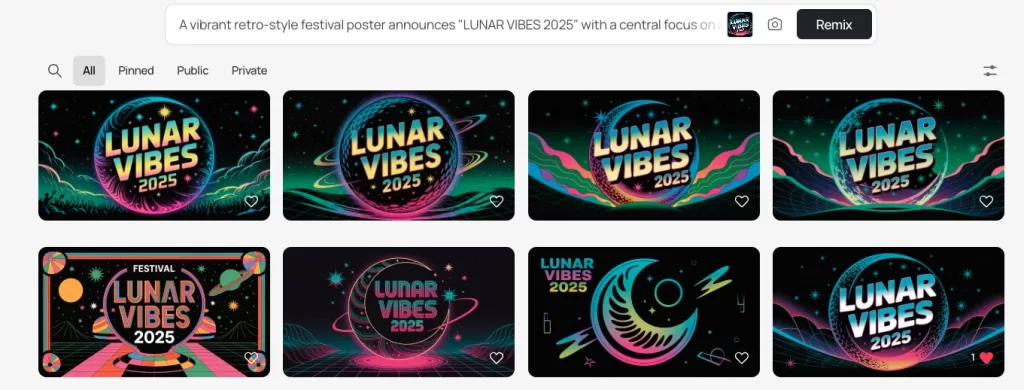
This is the fastest way to iterate on a design without starting from scratch. You can do this with your own images or images shared by others (if remixing is enabled).
👥 5. Power Users: How Marketers Can Get the Most Out of Ideogram
If you’re running campaigns, building content calendars, or just trying to stay ahead of your social media schedule—Ideogram is a shortcut to visual ideas that don’t need a designer (yet).
Here’s how marketers can make it work:
📌 What to use it for:
- Social media graphics with promo text
- Bold callouts for paid ads
- Poster-style teaser images for events or launches
- Typography-led Instagram posts
- Quick campaign mockups (try a few visual routes before briefing design)
🧠 Prompt Ideas for Marketers:
“Poster that says: 50% OFF THIS WEEKEND ONLY, minimalist black text, red background”

As you can see here, even Ideogram isn’t infallible when it comes to text — in the first image, WEEKKEND is spelled incorrectly (so you could use the ‘Remix’ feature above to rerun this)/
✅ Bonus tip:
Use Ideogram for MVP branding—logos, taglines, colour combos—for new campaigns, sub-brands or event assets. You can test 5 looks in 5 minutes and get stakeholder feedback before the designer even opens Figma.
👥 6. Power Users Continued: Creators, SMBs, Educators
🎨 For Creators & Designers
Whether you’re a digital artist, YouTuber, podcaster, or print-on-demand dabbler, Ideogram is a playground for creative iteration.
Use it for:
- Album covers, podcast art, YouTube thumbnails
- T-shirt mockups or sticker designs
- Personal logos, avatars, banners
- Aesthetic moodboards or typography-led artwork
Prompt ideas:
“T-shirt design that says: Trust the Process, 70s retro style, bold colours”

“Podcast cover art for: The Digital Drift, glitchcore style, purple and black, clean typography”
💡 Tip: Try variations to explore visual “takes” on a concept. It’s like getting multiple drafts for free.
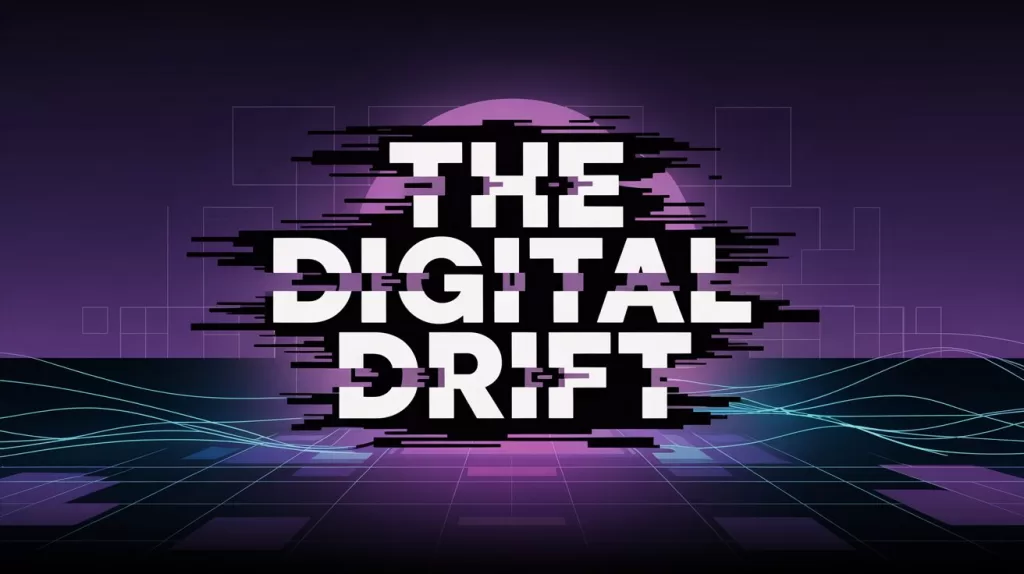

🛒 For Small Business Owners & Entrepreneurs
You don’t need to be a designer to make your brand look like one. Ideogram gives you fast, low-effort visuals to test and showcase your business.
Use it for:
- Logos, flyers, business cards, promo posts
- Etsy or Shopee store banners
- Popup event posters or in-store signage
- Social content with callouts or quotes
Prompt ideas:
“Logo for: Bean & Co Coffee Bar, minimalist black on white, modern serif font”

“Flyer that says: Pop-up This Saturday, 11am–6pm, local art and food, vibrant colours, community vibe”

Or use together:
“Logo for: Bean & Co Coffee Bar, minimalist black on white, modern serif font” “Flyer that says: Pop-up This Saturday, 11am–6pm, local art and food, vibrant colours, community vibe”

📦 Tip: Pair with Canva or a print service to turn your images into usable templates or assets.
📚 For Educators & Students
Great for classroom projects, quick visual storytelling, or just making your slides way more interesting.
Use it for:
- Posters, infographics, classroom signage
- Book or film “cover” assignments
- Slide visuals or explainer imagery
- AI storytelling or creative writing pair-ups
Prompt ideas:
“Poster that says: Save the Rainforest, student project, bright and bold, friendly cartoon style”

“Visual story: The Robot Who Wanted to Be a Painter, digital illustration, children’s book style”

📖 Tip: Students love remixing each other’s prompts—great for creative iteration in a classroom setting.
🧪 7. Experiment Lab: Fun Prompt Challenges to Try
Kickstart your creativity with these mini challenges:
🧢 “Design a t-shirt for your dog’s startup”
→ Prompt: “Logo that says: BarkTech, playful dog tech startup, futuristic blue and green”
🎬 “Make a movie poster for a film that doesn’t exist”
→ Prompt: “Movie poster for: Moonlight Over Osaka, noir romance, neon style, rain background”
🎤 “Create an album cover based on your mood right now”
→ Prompt: “Album cover for: Calm Chaos, ambient music, blue waves and soft light”
💡 These can be great warm-ups before serious projects—or just a way to explore visual directions without pressure.
🧙♂️ 8. Pro Tips & Prompt Magic
Here’s where things get spicy. A few insider moves to level up your Ideogram game:
🔤 Better Text Results
- Always use “that says:” or “with the text:” to guide readable copy
- Avoid long sentences—short phrases and bold text work best
- Use quotes sparingly (e.g.
that says: “Be Kind”) for cleaner rendering
⚖️ Prompt Balance
- Keep a clear subject and mood—don’t overload with style mashups
- Use fewer modifiers to control clutter
(“clean” > “vintage + neon + graffiti + smoke + metallic”)
🙅 Negative Prompts That Work
Add to your prompt:
- “no blur”
- “no watermark”
- “no extra text”
- “plain background”
♻️ Remix vs Starting Over
- Use Remix to refine one idea quickly
- Start fresh if your original prompt is too muddled—simpler is often better
🗃️ Build Your Prompt Library
Keep a notes doc or Notion page of prompts you like.
Label them: “Event Poster,” “Logo Style 1,” “Inspirational Quote Card,” etc.
Reuse and tweak them like ingredients in your own creative kitchen.
💾 9. Save, Share & Remix Like a Pro
✅ Saving Images
Click the image, then use the download button for the highest resolution.
Want it background-free? Use a background remover (e.g. remove.bg) for logos or stickers.
🔄 Remixing Others
Browse the Explore tab to see what others are making.
Click Remix on anything that inspires you—it brings in the prompt, so you can tweak and build on it.
✨ Always credit or shout out creators if you use their prompt as a starting point.
📁 Build a Brand Set
Make 4–5 versions of your logo in different styles (e.g. minimalist, vintage, bold).
Use them across socials, packaging, site banners.
This works especially well for side hustlers or new ventures.
⚖️ 10. Where It Shines vs Where It Struggles
| Strengths | Watch-outs |
|---|---|
| Amazing at text in image | Not built for photorealism |
| Fast and user-friendly | Complex scenes can get cluttered |
| Great for branding, posters, signage | People or detailed realism? Use Midjourney instead |
| Easy Remix and Community culture | Limited control vs pro tools like Photoshop |
🚀 Final Thought: Why Ideogram Deserves a Spot in Your AI Toolkit
You don’t need to be a designer to look like one—and Ideogram makes that possible. For anyone who’s ever opened Canva and wished they had a logo, a flyer idea, or just a vibe to work with, this tool is an instant creativity unlock.
It won’t replace a professional design team—but it will help you ideate faster, iterate better, and bring your ideas to life in minutes.
🎁 Bonus: 10 Ready-to-Use Prompts to Copy & Tweak
Want to hit the ground running? Here are 10 plug-and-play prompts you can paste into Ideogram right now. Tweak the text, colours or style to match your brand or project.
🔖 Logos & Branding
Logo that says: [Your Brand Name], modern minimalist style, black text on white background
Logo that says: [Your Cafe Name], handwritten font, earthy colours, clean layout
🛍️ Marketing & Promotions
Poster that says: SALE ENDS TONIGHT, bold red text on white background, simple design
Instagram post for new collection: [Your Product], modern style, pastel colours, clean layout
👕 Merch & Creators
T-shirt design that says: Stay Curious, 90s aesthetic, bold colours, graphic style
Album cover for: [Band or Vibe], dark glitchcore aesthetic, neon blue and purple
🎓 Educators & Events
Classroom poster that says: Kindness Matters, playful cartoon style, rainbow colours
Flyer that says: Open House This Friday, student event, friendly bold text, bright layout
Advertisement
💡 Fun & Experiments
Meme that says: When the Wi-Fi Drops One Bar, simple comic style, white background
Festival poster for: Cloudwave 3025, synthwave colours, cyberpunk vibe, black background
You can save your favourites, remix others, or create a swipe file of go-to prompts for every mood, season, or campaign.
✌️ That’s a Wrap – Go Play, Remix, and Create
Ideogram.ai isn’t just a tool—it’s a creative playground for anyone with a keyboard and an idea. Whether you’re building a brand, making memes, designing merch, or just having fun, it gives you a low-barrier, high-reward way to bring your words to life.
And the best part? You don’t need to be a designer. Just someone willing to play.
See you in the prompt bar. 🎨
What Do YOU Think?
Share your own personal tips and experiences below. Which prompt worked best for you?
This article is part of our Prompt and Play series
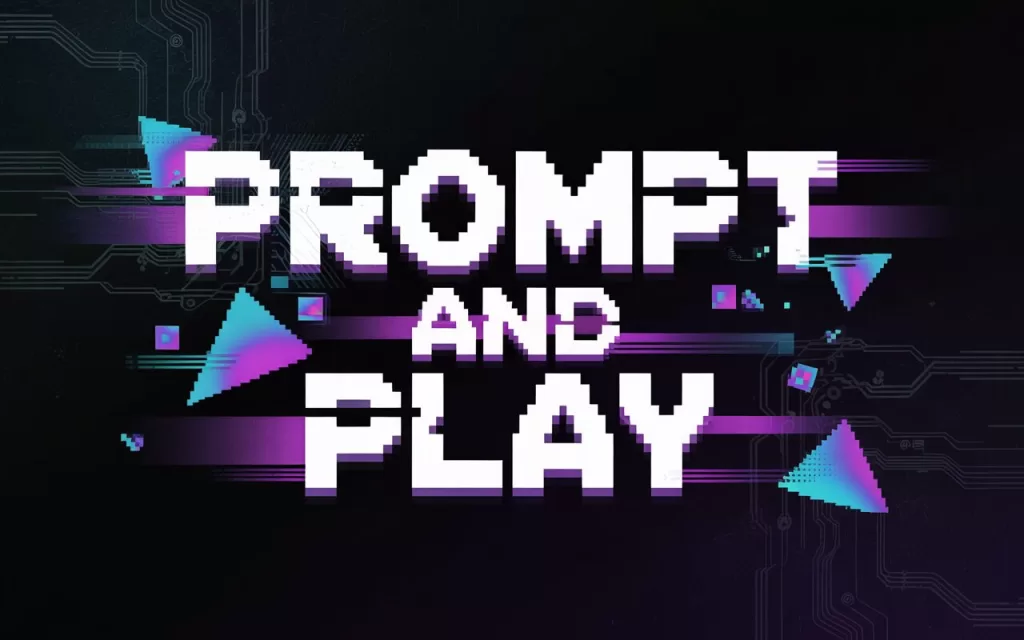
You may also like:
- 10 AI Prompts to Turn Your Pet Photos Into Phone Wallpapers (Plus Freebies!)
- Top AI Image Generators of 2024 and 2025
- Tap here to visit Ideogram.ai
Author
Discover more from AIinASIA
Subscribe to get the latest posts sent to your email.
Tools
Can AI Videos Really Boost Your Brand’s Authenticity?
AI-generated videos are reshaping brand authenticity and trust among audiences. Discover actionable insights: 2025 AI Sentiment Report.
Published
1 month agoon
April 8, 2025By
AIinAsia
TL;DR – What You Need to Know in 30 Seconds
- Consumers overwhelmingly accept AI-generated videos, seeing them as innovative and authentic.
- Brands must transparently disclose their use of AI to enhance trust.
- High-quality, personalised content blending AI with human creativity is critical for engagement.
How Brands In Asia Can Navigate Trust, Transparency, and Creativity Through AI-generated Video Content
Picture this: your favourite brand releases an amazing video campaign that grabs your attention, moves you, and makes you want to share it instantly. Now imagine learning that this compelling video wasn’t crafted by humans alone—it was produced using AI. Would your trust in that brand suddenly plummet, or would you see it as innovative?
The answer might surprise you. A recent global survey of 2,385 consumers has shown a fascinating shift: the majority not only accept but actively embrace AI-generated videos.
Let’s dig into what this means for brands across Asia, and how you can harness AI video to boost creativity, authenticity, and consumer trust.
The AI video landscape: a quick snapshot
Video has become the lifeblood of digital communication. In 2023 alone, over three billion people worldwide engaged with video content, solidifying its role as the content king. Today, 86% of businesses rely on video marketing, and the data tells us why: 90% of consumers confirm that videos significantly influence their purchasing decisions.
As the appetite for engaging, relevant video content grows, brands face the challenge of creating high-quality videos swiftly and affordably. Enter AI-generated videos—a game-changer that promises efficiency, creativity, and scale. But is the audience on board?
Seven essential insights brands need to know from the 2025 AI Sentiment Report:
1. Audiences are comfortable with AI-generated videos
- 90.9% have no issue with brands using AI-generated videos.
- Words like “innovative,” “modern,” and “efficient” regularly cropped up, reflecting a positive shift in consumer sentiment.
2. AI enhances authenticity and creativity (yes, really!)
- 89.1% said AI doesn’t negatively impact brand perception.
- 62.8% agree AI-generated videos enhance brand creativity and storytelling.
- Smaller brands now have a chance to compete creatively with big-budget campaigns, levelling the playing field significantly.
3. Transparency isn’t optional
- 75.6% consider transparency about AI usage essential.
- Audiences prefer clear labels/icons (59.4%), descriptions (25.5%), or social hashtags (13.7%) to indicate AI-generated content.
4. Human creativity still matters—a lot
- A striking 85.5% of respondents react positively when human involvement complements AI-produced videos.
- Brands that blend AI efficiency with human touch achieve stronger engagement and mitigate authenticity concerns.
5. Quality directly impacts trust
- Over half (54.2%) say high-quality AI videos increase brand trust.
- Conversely, poor-quality videos quickly erode consumer confidence (10.3% lose trust).
6. Social media leads, but don’t neglect other platforms
- Social media tops the list (69.4%) for consumer comfort with AI-generated videos.
- Tutorials (31.1%), product demos (30.4%), and even customer support (27.3%) show AI video’s remarkable versatility.
7. Personalised content drives deeper engagement
- 52.2% engage more with high-quality videos, while 25.1% prefer personalised content.
- This highlights the need for strategic targeting and tailored storytelling for Asian consumers, who value relevance highly.
Actionable roadmap for Asian brands: combining AI with authenticity
The path forward is clear for Asian brands aiming to harness AI-generated video effectively:
- Prioritise transparency: Clearly label AI-generated content using recognisable icons or descriptions. Consumers value openness—so shout it loud and clear.
- Invest in quality: Use advanced AI video tools to produce professional, lifelike, and compelling content. Your audience expects—and rewards—excellence.
- Blend AI and human creativity: Don’t rely on AI alone. Human storytelling enriches AI-generated content, creating videos that resonate emotionally with viewers.
- Choose your channels wisely: Deploy AI videos strategically on social media, tutorials, product demos, and customer interactions. Meet your audience where they feel comfortable engaging.
- Personalise, personalise, personalise: Craft targeted messages that reflect your audience’s interests, values, and cultural contexts. Especially in diverse Asian markets, personalised content ensures deeper connections.
Final thoughts: Is AI the future of video marketing in Asia?
Absolutely. AI video isn’t just a flashy tech trend—it’s rapidly becoming essential to effective digital storytelling. Asian brands have an exciting opportunity to lead in this area by balancing innovation with transparency and authenticity.
As AI continues to evolve, expect more immersive, interactive experiences that redefine consumer engagement. Embrace this evolution now, and you’ll set your brand up not just to meet—but exceed—consumer expectations.
Ready to explore more on AI’s growing role in shaping consumer sentiment in 2025?
Keep following AIinASIA for deeper dives and practical insights.
You may also like:
- You can download the full report for free by tapping here
- Unveiling the Dark Side of AI: The Transparency Dilemma in the AI Market
- Unleash Your Inner Artist with Google Gemini’s Free AI Image Generator
Author
Discover more from AIinASIA
Subscribe to get the latest posts sent to your email.

Adrian’s Arena: Will AI Get You Fired? 9 Mistakes That Could Cost You Everything

FAKE FACES, REAL CONSEQUENCES: Should NZ Ban AI in Political Ads?

7 Mind-Blowing New ChatGPT Use Cases in 2025
Trending
-

 Marketing3 weeks ago
Marketing3 weeks agoPlaybook: How to Use Ideogram.ai (no design skills required!)
-

 Life2 weeks ago
Life2 weeks agoWhatsApp Confirms How To Block Meta AI From Your Chats
-

 Tools5 days ago
Tools5 days agoEdit AI Images on the Go with Gemini’s New Update
-

 Business2 days ago
Business2 days agoAI Just Killed 8 Jobs… But Created 15 New Ones Paying £100k+
-

 Business2 weeks ago
Business2 weeks agoChatGPT Just Quietly Released “Memory with Search” – Here’s What You Need to Know
-

 Life1 day ago
Life1 day ago7 Mind-Blowing New ChatGPT Use Cases in 2025
-

 Life2 days ago
Life2 days ago“Sounds Impressive… But for Whom?” Why AI’s Overconfident Medical Summaries Could Be Dangerous
-

 Life4 hours ago
Life4 hours agoAdrian’s Arena: Will AI Get You Fired? 9 Mistakes That Could Cost You Everything









